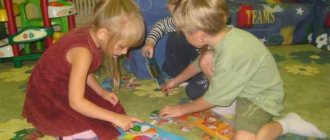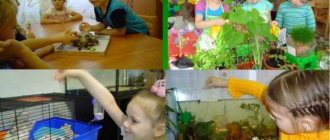MAGAZINE Preschooler.RF
Outline plan for conducting independent artistic activities (theater-speech, visual, musical) for pupils in the afternoon in the senior group. Author of the development: Voinova Irina Petrovna, teacher of the first category, MBDOU TsRR kindergarten No. 282 Program content: - promote independent organization of the game in “theater”; - continue to teach how to convey the text of a fairy tale sequentially; - use in speech expressive means characteristic of Russian folk tales (beginning, repetitions, songs of characters, etc.); - take initiative in decorating the scenery for the theater (painting fairy-tale houses, trees, bushes, berries); - on their own initiative, students select the simplest melodies on musical instruments; -nurture creative abilities. Organization of independent artistic activities Prepare material for visual activities (brushes, gouache, watercolor, natural material). Prepare equipment for musical activities Prepare materials and equipment for theatrical and speech activities (puppets, screen for a puppet theater, tickets for the theater, box office for selling tickets, cardboard for making scenery). Course of theatrical and speech activity Educator: Guys, you and I have gone to the theater more than once, watched performances and puppet theaters there. Who do you think presents us with the opportunity to watch performances? (Children's answers). That's right, these are the people who work in the theater. Let's remember what professions we met while visiting the theater? (Children's answers). Who can tell me what artists do in the theater? (Children's answers). What is a cashier needed for? (Children's answers). What is the duty of ticket takers? (Children's answers). Would you like to organize your own theater? The guys in our group have prepared a small performance for you, but do they need helpers: ticket takers, a cashier, artists to decorate the scenery and prepare the stage for the performance? Who wants to help them? Who will be our artists, cashier, ticket takers? (Selection of children for these roles) And the rest of the children will be spectators. Before the performance we have time, and so that the audience does not get bored, I prepared everything they need so that they can draw their favorite fairy tale or make a fairy-tale hero from natural material. At the end of the performance, we will arrange an exhibition: “My favorite fairy-tale hero.” But before we each start doing our own activities, I want to know if you know the rules of conduct in a theater or other public place. Who wants to tell them? (Children's answers). And now all the guys calmly begin their duties. After the invitation, when the theater workers have everything ready, we will buy tickets and go into the auditorium. The children go to their places: the audience is engaged in visual and musical activities, the artists are preparing the puppets, the auditorium, the artists are decorating the stage, the cashier is preparing his future workplace, and the ticket takers are helping to prepare the auditorium. At the end of all this work, Parsley appears. Parsley: Whoever doesn’t believe it, let him check, I’m glad to have any guest. I open the doors to the fairy tale, invite all the children (Children go to buy tickets and take seats in the hall. Make sure that tall children sit in the back seats, and little ones and girls sit in front) Presenter: The fairy tale is rich in wisdom, Let's tell the fairy tale to come. This is a saying, guys, The fairy tale will be ahead Russian folk tale “The Snow Maiden and the Fox” (Puppet theater performance by children). At the end, the teacher asks the children if you liked the fairy tale, Which character did you like best? What were the fox, bear, wolf, and Snow Maiden in the fairy tale? Now let's look at the work you, the audience, did before the performance. (Review and short analysis of works). Based on your work, it turned out that these are your favorite fairy-tale characters, next time we will stage another performance with you.| Next > |
Language acquisition is the most important task of preschool education. Its relevance is especially great in our time, when there is a widespread decline in culture. We must begin this work as early as possible, otherwise it will be difficult for our children to become successful in adulthood.
The main task of developing figurative speech is to instill in children a love for the literary word and respect for the book; introduce those works of fiction that children need to read, tell, and memorize.
At the present stage, artistic and speech activity is considered not only as a means of developing expressiveness and figurative speech, but also as a means of developing children’s creative abilities.
Therefore, while working on the topic of creative search “Artistic and speech activity of a preschooler,” I solve problems in the formation of artistic and speech activity as one of the integral parts of the aesthetic education of children.
I believe that the most important sources for the development of expressiveness of children's speech are works of fiction and oral folk art, including small folklore forms (proverbs, sayings, riddles, nursery rhymes, counting rhymes, phraseological units).
When introducing works of fiction, I try to give children an idea of the features of the genre, reveal the ideological and artistic meaning of the work, and show the beauty and poetry of the images and language.
My practice of working on this topic shows that through organized educational activities, children acquire a certain amount of skills and abilities in artistic and speech activities.
Therefore, for this purpose, I read and tell fairy tales and stories to children, learn poems with them, teach them how to elementary analyze texts, retell and dramatize short literary works, inventing my own short fairy tales, stories, riddles in order to
induce in children a desire to use the acquired knowledge in everyday life.
However, my observations show that preschoolers are not always able to independently engage in artistic and speech activities. Therefore, I use the time free from classes in the afternoon on the topic of my creative research on the artistic and speech activities of children.
In order to expand and consolidate children's knowledge about books, I created and decorated a special area in the group room in which children can leaf through books they know, look at the illustrations in them, listen to fairy tales recorded on gramophone records, cassettes, disks, and retell what they have read to their friends using theater of toys, shadows, puppets, flannelograph, play literary games, prepare for holiday matinees, evenings of entertainment.
And organizing excursions to a bookstore, a children's library, or a city library for adults will intensify the children's activities in the book corner.
To generalize and consolidate knowledge on the topic of creative search, I conduct literary entertainment, such as: “Books are our friends,” Visiting the Queen of Literature.”
My children, in their free time from classes, being impressed by the literary works they listened to (fairy tales, short stories, poems), recreate the images they liked in drawing, appliqué or modeling.
I believe that the main goal when organizing literary games is to develop children’s artistic taste, imagination and creative thinking, and the formation of coherent speech. Together with the children, I organize the following literary games: “Let’s draw a fairy tale,” “Come up with a story, a fairy tale based on a drawing (or a picture), “Tell a fairy tale based on pictures,” and others.
Gradually, as the child develops the necessary skills and abilities and acquires the necessary knowledge, my role becomes secondary, because I give the children more freedom, and I only help them in cases where they find it difficult in some way.
I place all the children’s drawings and writings in an album of children’s creativity. This could be a baby book for an individual child, an album in which stories, fairy tales, poems, and riddles invented by children will find a place.
At the end of the school year, I organize an exhibition of children's creativity and hold a joint conference of educators, parents, and primary school teachers.
The interconnected components of artistic and speech activity of preschoolers are not only the perception of a literary text, its reproduction (reproduction), but also elementary verbal creativity.
I develop verbal creativity in children by inventing riddles, writing fairy tales and stories. Children themselves find visual means, comparisons, epithets, come up with the composition of fairy tales, stories (beginning, main part, ending), choose images of characters and show them on a flannelgraph or use a flat tabletop theater.
Play-dramatization is the most accessible and interesting way for a child to process and express impressions, knowledge and emotions and at the same time an effective means of understanding the subtext of a literary or folklore work. This method of conveying a fairy tale or story is most popular among older preschoolers. It allows children to learn how to correctly construct dialogues and monologues, describe phenomena and objects.
Artistic and speech development contributes to the development of children’s creative and intellectual abilities and their speech culture, the formation of an emotionally positive attitude towards the world around them in preschoolers, and contributes to the formation of artistic and speech activity.
Thus, a competent approach of teachers when organizing artistic and speech activities contributes to the development of not only speech skills, but also the creative abilities of children.





